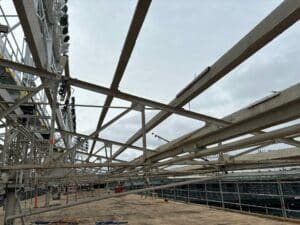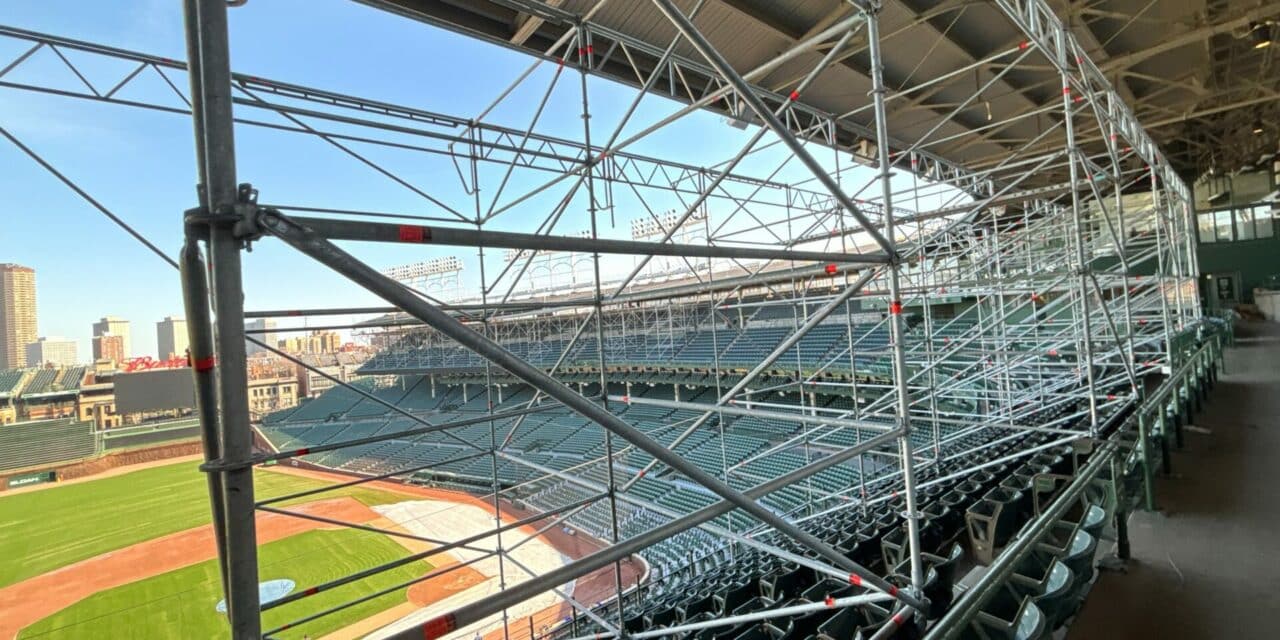RAISE THE ROOF: The new steel-framed roof at Wrigley Field, shown here in the early stages of the project, replaces the old wood structure that was 90-plus years old. (Courtesy Combined Roofing)
Team to explore options for repurposing wood structure
Wrigley Field sports a new roof covering the upper deck after replacing a structure that dates to the late 1920s, which was part of expanding the Chicago Cubs’ ballpark that opened in 1914.
The new roof, spanning about 57,000 square feet from the corners of left field to right field, replaced all of the old wood structural beams and slates with high-strength steel, topped off with installation of a new asphalt-based, waterproof roof membrane.
It took five months to complete over the offseason and cost several hundred thousand dollars, said Cubs senior vice president of operations David Cromwell, without mentioning the specific dollar figure.
Local firms Shamrock Construction and Combined Roofing were the contractors for the job. Construction started in early November, immediately after the Iowa-Northwestern college football game, and went on during the Cubs’ annual winter festival over Thanksgiving, Christmas and New Year’s Day. The Cubs’ 2024 home opener is April 1 against Colorado.
Replacing the old roof may not sound as sexy as Wrigley’s bunker clubs, videoboard and all of the new development adjacent to the historic ballpark that’s taken place over the past decade, but considering the ballpark’s vintage, the Cubs were surprised to discover a substantial portion of the wood was in good shape, given the roof structure was 90-plus years old.
As they removed the existing material, the Cubs contacted a dendochronologist from Denver, Colorado to help them understand more about the wood itself. The report he issued stated that most of the wood came from Douglas fir trees, which were several hundred years old at the time, Cromwell said.
“We were able to salvage several hundred pieces of wood and had some curiously for where it came from and how old those trees may have been,” he said. “We have some ideas in the works about how we can repurpose the wood for other uses. There’s an opportunity to get creative and a good story to talk about. Because we weren’t expecting it, we need to spend some time thinking about it.”
It’s unclear whether those ideas extend to the Cubs potentially selling those pieces of wood to fans as a Wrigley Field memorabilia item.

MADE OF STEEL: Wrigley Field’s new steel roof starts to take shape in this photo. Construction took five months to complete. (Courtesy Combined Roofing)
Elsewhere, there are a wide range of examples of sports venue infrastructure repurposed for other uses at arenas and stadiums.
Most recently, Gainbridge Fieldhouse, the NBA arena in Indianapolis, integrated pieces of the old Market Square Arena hardwood court to help form an LED wall inside the one of the building’s premium clubs as part of a major renovation. In the college market, new Baylor University’s new Foster Pavilion attached a portion of the 2021 NCAA Final Four court to a concourse wall in the arena.
Plus, some teams have reused concrete from their old buildings that were demolished to build new facilities, such as Tottenham Hotspur Stadium in London, England, a Premier League and NFL venue.
In Chicago, small repairs were made to patch up Wrigley’s old roof over the years, including replacing the portion over the press box that may not have been part of the original structure.
The offseason project marks the first time the roof has been replaced in total. It’s among the final pieces of renovating Wrigley after the 1060 Project, a $760 million investment, was completed five years ago. The Ricketts family, owner of the Cubs and the ballpark, has paid for all improvements.
“This project aligns well with the Ricketts family’s ongoing effort to preserve Wrigley Field for future generations and ensure that the roof is going to be in great condition for a very long time,” Cromwell said.
To the naked eye, there’s no difference between the new roof and the old one, he said, which falls in line with the look and feel of Major League Baseball’s second-oldest facility that’s listed on the National Register of Historic Places.
Elsewhere at Wrigley, the Cubs are finishing up the replacement of several hundred premier seats in the bowl, tied to four club lounges. Irwin Seating produced more durable seats to replace the old ones that were installed in 2018-19, but have gone through wear and tear between Chicago winters and peak baseball season with sun and rain, Cromwell said.
In addition, new exterior LED lighting on the field on the field towers around the ballpark has been installed, providing the Cubs with the opportunity to highlight Wrigley’s unique architectural features that no other ballpark has, he said.
Editor’s Note: This story has been updated.







